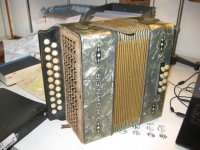ccaissie
Newbie
Suddenly want to begin Cajun-type honking and tooting. I had learned as a kid on a large full Galanti box, which I still have, but played a small piano type in a Morris Dance group in Alaska.
Warning....do not play accordion in a bar.....Alaskan women think it's fun to sneak up and goose you while both hands are busy on the keys.
If you have particulars on this vintage and style of this C/F Hohner, please inform me. Since I have played Blues Harp Harmonica, the keys and push-pull are quite familiar.
Also, there is some blockage of one reed so I will pull it apart for cleaning. I am interested in changing the temper from the Standard tuning to more Cajun type intonation. Since I'm a telescope maker and have instrument repair skills, I think this is do-able. Whadda you think, bro?
Warning....do not play accordion in a bar.....Alaskan women think it's fun to sneak up and goose you while both hands are busy on the keys.
If you have particulars on this vintage and style of this C/F Hohner, please inform me. Since I have played Blues Harp Harmonica, the keys and push-pull are quite familiar.
Also, there is some blockage of one reed so I will pull it apart for cleaning. I am interested in changing the temper from the Standard tuning to more Cajun type intonation. Since I'm a telescope maker and have instrument repair skills, I think this is do-able. Whadda you think, bro?

